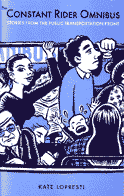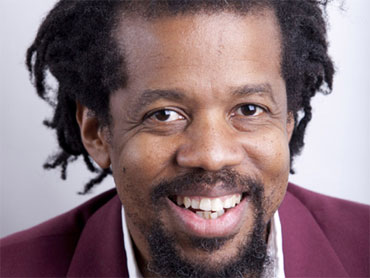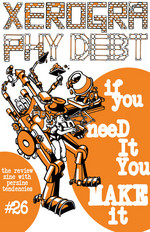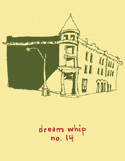INTERVIEW WITH KATE FROM THE CONSTANT RIDER ZINE!
Kate Lopresti is the editor and author of the Constant Rider book and zine series, a collection of stories from the world of public transportation. We caught up with Kate to see what she’s been up to lately…

Q: There hasn’t been a new issue of Constant Rider in a while. Do you have any new projects coming up?
A: Well, the good news is that three years ago I found a job that reduced my commute considerably from the days I had to get from southeast Portland to a northwest suburb to get to work. An unintended consequence, though, was that spending less time on the bus gave me less to write about. I just don’t see as much rider-interaction in a 20-minute bus ride. I have been biking more, so there may still be a Constant Rider bike issue. I’ve also taken up gardening, which has been great, but certainly cuts into writing time.
Q: How have your feelings changed about public transportation since the book came out?
A: I was really encouraged in the summer of 2008, when gas prices hit $4 a gallon. People I knew who were adamant single car drivers began to see the value in taking the bus and biking. It was a real sea change. I’m only sad the price hike didn’t last longer. Still, it was a good experience to see there are a number of drivers out there who can be recruited to ride public transportation under certain circumstances.
Q: If you had to stick with one mode of transportation for the rest of your life what would it be?
A: I’d have to choose my bike. (Sorry, bus!) Between the self-sufficiency and the exercise, a bike makes the most sense.
Q: What’s your opinion on bike culture as a means to beat the gas crisis blues?
A: Bikes are excellent, and not just in terms of reducing our fuel costs. They help us reduce carbon emissions and get us exercising. But spelling out the benefits of biking isn’t enough to get people to ride. The problem we’re seeing in Portland is that there are many people willing to bike, but not confident that they can do it safely in their neighborhoods to get to work or school. They have no trouble taking their bikes to dedicated bike paths or recreational areas, but getting into traffic is another story. Despite Portland’s strong bike culture, its infrastructure—bike paths, signals, parking—could be improved.
Q: If you could tell the world to read one book or zine what would it be?
A: Lately I’ve really been enjoying the columns of Thomas L. Friedman in the New York Times. He continually makes the case for green technologies and reducing American dependence on foreign oil. His book, Hot, Flat, and Crowded is on my To Read list.
 “Are you serious?!” That’s what I said when I first learned what happened to Don. The deep sense of bewilderment and disbelief I felt seemed to be shared by many. It was a tragedy in the true sense of the word.
“Are you serious?!” That’s what I said when I first learned what happened to Don. The deep sense of bewilderment and disbelief I felt seemed to be shared by many. It was a tragedy in the true sense of the word.


 [Recording made by secret tape recorder in the Oval Office]. Nice place, Mr. President! And look at all these couches! Would you mind if I crashed on one tonight? [Inaudible]. Hah. I’m just kidding. Anyway, I know you’re busy, but I wonder if you’d like to check out my zine? [Inaudible]. Well, it’s sort of a book. [Inaudible]. Yes, I wrote it myself. [Inaudible]. Thanks, I try to write neatly. [Inaudible]. It’s mostly about wandering around and getting lost and feeling all the stuff you feel when you’re on the road. [Inaudible]. No, those aren’t kindergarten drawings. [Inaudible]. I drew them. [Inaudible]. Yes, I’m serious. [Tape ends].
[Recording made by secret tape recorder in the Oval Office]. Nice place, Mr. President! And look at all these couches! Would you mind if I crashed on one tonight? [Inaudible]. Hah. I’m just kidding. Anyway, I know you’re busy, but I wonder if you’d like to check out my zine? [Inaudible]. Well, it’s sort of a book. [Inaudible]. Yes, I wrote it myself. [Inaudible]. Thanks, I try to write neatly. [Inaudible]. It’s mostly about wandering around and getting lost and feeling all the stuff you feel when you’re on the road. [Inaudible]. No, those aren’t kindergarten drawings. [Inaudible]. I drew them. [Inaudible]. Yes, I’m serious. [Tape ends].